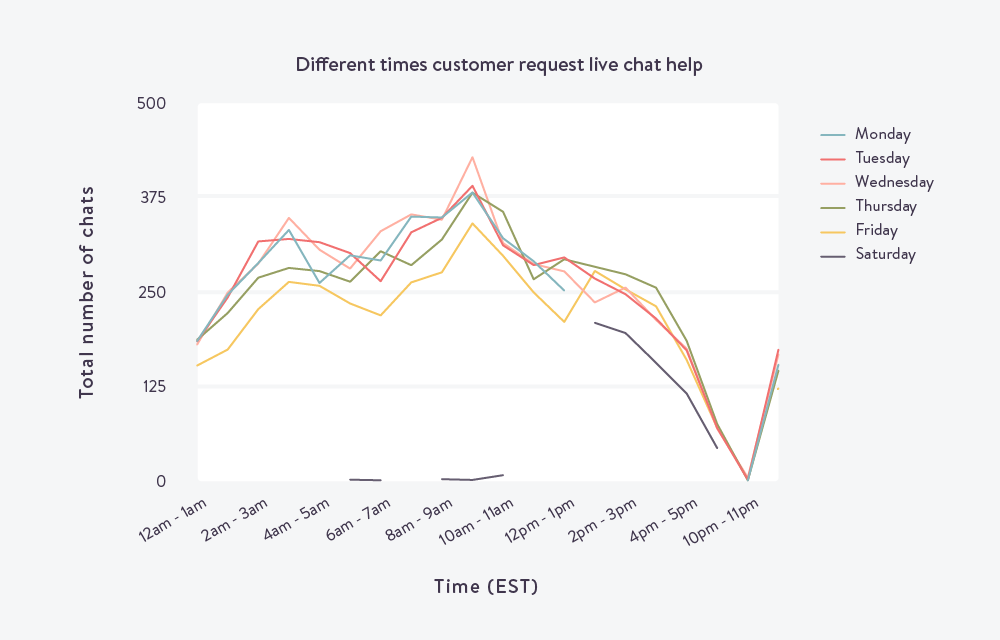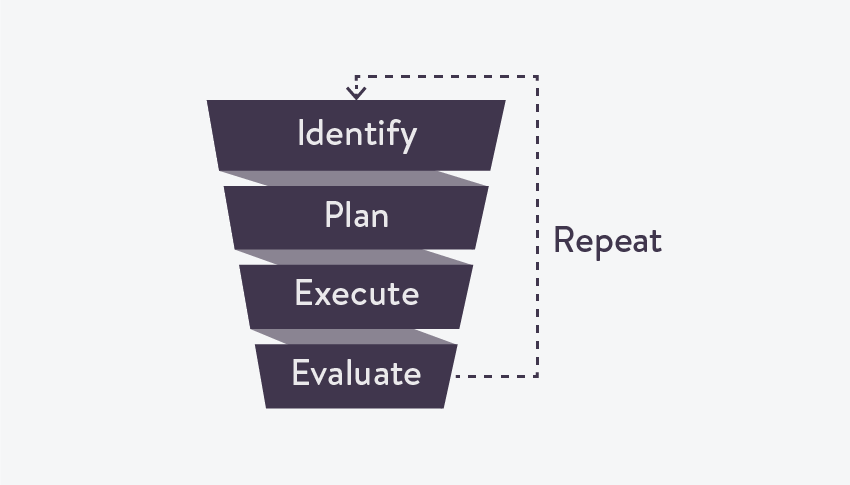Anguish over your metrics failing to meet your performance benchmarks is tough for any support team. It can make you feel like you’re not doing your job properly. Or worse, that you’re leaving your customers hanging around waiting to receive help.
Each support channel demands different expectations from your support team. For live chat to really hold up its name, the agent must be present:
- Almost a fifth of customers rate long wait times as the most frustrating part of a live chat — they don’t want to be in a queue.
- Most customers refuse to wait more than five minutes for a response.
Support metrics are crucial at Kayako. We’re passionate about giving customers help when they need it. For live chat, that means responding to customers quickly and streamlining chat handling times.
In 2016 Kayako’s support team worked on a six-month project aimed at improving chat availability, average chat handling time (CHT) and first response time (FRT). The first step was diving deep into our metrics and understanding ways we could reduce our average handle time for chats.
Stage 1: Identify reasons for high average handle time
The first step was all about identifying where the team needed to focus most.
We downloaded three months (or one-quarter’s) worth of data from Kayako and created a live chat metrics worksheet. Here’s a sample of our live chat performance metrics over a three-month period:
| Chat support metric: | Analysis over three months: | Analysis from the busiest month: |
| Total number of chats | 7586 | 2536 |
| Number of unanswered/timed out chats | 2592 | 661 |
| Total chat duration (hours:minutes:seconds) | 2374:25:06 | 885:40:16 |
| Average handle time (minutes:seconds) | 28:31 | 27:13 |
| Total wait time (hours:minutes:seconds) | 86:15:28 | 15:29:48 |
| Average wait time (minutes:seconds) | 24:28 | 30:70 |
At first the numbers did not make for pleasurable reading! Why was average wait time and average handle time so high?
Chat availability stats were in need of improvement. After discussion amongst the team, it was agreed the team would focus on:
- Chat Handling Time (CHT): – The average and total time taken by agents to handle a chat.
- Chat availability – Percentage of total handled or missed chats by the support team.
- First Response Time (FRT) – The average time taken by an agent to accept and respond to an incoming chat request.
Our mission was to see how much we could improve these metrics over six months.
An automatic weekly email was set up to list reports for: the number of chats handled, number of chats missed, total and average wait time on chats, and total and average CHT.
From our initial analysis, it was clear significant improvements were needed in both planning and execution.
Stage 2: Create an action plan to be more available and reduce AHT
We needed an action plan. This involved two phases:
- Current observations from the team that needed improvement
- Steps to fix these observations.
We outlined our action plan in a collaborative Google sheet. It contained action steps to address each metric separately.
This action plan was drawn from monthly selections of weekly data collected during the identification stage.
Action plan to decrease wait time in chats:
| Observations: | Fixes: |
| 1. Stepping away from the computer (for any reason) and leaving status as “Online” in Kayako. | Check before going for a break, configure setting in Kayako to be auto-away when system is idle. Set yourself as “Away” while not at your desk. |
| 2. Declining chats cause the wait time to increase. | Always accept chats if possible. |
| 3. If more than two chat requests appear, then declining or not accepting the chat immediately. | Accept chat and then invite, configure setting in Kayako. |
| 4. Taking too long to accept a chat when diagnosing an ongoing issue or doing something on Slack or other systems. | Accept chat immediately, customers expect a quick connection. |
Action plan to increase team availability:
| Observations: | Fixes: |
| 1. No checks took place to see if chat is available | Make a single point of contact for the chat team who will check that chat remains available. |
| 2. Choose a minimum number of available team members at which we don’t accept chats | Stop accepting chats if there are fewer than 4 people available. |
| 3. Effective use of team members who are on email conversations | Make use of email team if the chat load is heavy and they are available to contribute. Chat team staff should also contribute to email conversations when the chat load is lighter. |
| 4. Break management (e.g. lunch and project time) | Better break management by staff who are on chats. Where possible, only one team member would be away from chats at any time. |
| 5. Leave management and training | 1. Be considerate that Wednesday is the busiest day of the week (as per chat trends) when booking time off.
2. Plan availability of staff. Team leads to handle availability of staff well in advance to avoid last minute adjustments. |
| 6. Better management of peak hours of chat workload | Breakdown chat numbers in 2 hour intervals and see if we can bring in more team members to help over peak hours: a) Run a report of conversations being created around shift handover b) Run a report of total number of chats getting created into conversations in work hours c) Do a heat map of incoming chats during usual work hours after running a report of all the chats we receive while we are online. |
There were six key steps to making sure we implemented our action plans to decrease wait times and increase chat availability:
1. Staff at the correct hours
One of the ways we addressed and tackled chat availability was making sure we were staffing at the right time.
We collected data for handled/missed chats across each hour of the day and split them into priorities for staffing: Red (busiest), light pink (busy), orange (average) and green (least busy). Here’s what our data looked like for our chat availability and AHT reduction project:


Now we knew where to distribute our team to handle the busiest and quietest hours.
2. Assign leaders to cover all staffing hours
Create a chat leader within each shift team with the responsibility of ensuring the chat remained available at all times by communicating and keeping a check on the chat status, and seeking help from other team members or leaders as needed.
3. Create a minimum number of staff needed to handle live chats
Decide a minimum threshold of concurrent chats a team needs to handle before safely assuming to put the chat status to unavailable. Factors included the current strength of the team and break timings needed by team members. The threshold was flexible sometimes depending on these factors.
4. Put guidelines in place around communicating break and leave management
It was important that staff took breaks and leave, but also just important to communicate these properly to the team. This ensured the team had enough bench strength to maximize availability at all times. We have a great culture at Kayako with flexible working hours and unlimited paid time-off, but we also understand the limits and manage ours accordingly by communicating with each other.
5. Train for best practices across live chat
Train staff to better handle chats and reduce the average handling time. Decreasing the chat handling time also means increasing chat availability so staff are able to get to more customers in the queue. This was achieved by the creation of video training, sharing tips, and effective measures staff can take when handling a chat.
6. Proper use of the “Away” setting
To improve average wait time on chats, staff members are expected to be more active in not keeping customers waiting when a chat request comes in. Staff should ensure they set their status to away when going on breaks to avoid unnecessary increases to wait time.
These are the steps we took. You can add more action steps depending upon your chat team structure and needs.
Your customer needs a quick answer. Provide tailored, real time service and get your customer back on track. Kayako Messenger is more than just simple live chat software.
Stage 3: Put it all into action
The most important stage was to execute the action plan.
With the help of our team leaders, the action plan was implemented for both the day and night shift teams. This was important. We emphasized the value of the project and its outcomes, and we were strict about monitoring the weekly data during the execution stage.
Stage 4: Benchmark your own live chat performance
The evaluation was conducted on a monthly basis and we saw minor improvements at each stage. The project was a continuous cycle of all stages so every evaluation followed the same path: Identify > Plan > Execute > Evaluate > Repeat. Insights data came in the middle of each stage and was important in planning the next stage.

Evaluate and analyze: Celebrate your results!
At the end of six months of continuous weekly trend analysis, planning, execution, and evaluations, it was time for the final results. We pulled the numbers out with phenomenal numbers for all metrics. We achieved some amazing results:
- 9% increase in chat availability
- 33% decrease in the average wait time on chats
- 10% decrease in our chat handling time – or a 3-minute decrease for AHT in live chat
The real stars of the show were the support team members. They were thrilled by the results! This doesn’t stop here: we are continuously evaluating how we can further improve our chat metrics to provide a better experience to our customers.
Conduct your own live chat performance project
Over to you – if you work in a support team and are looking for ways to contribute and improve the experience for your customers, you can carry out a metrics project too! Apply the basic cycle of project management: Identify > Plan > Execute > Evaluate > Repeat. Remember that data plays a key role and you will need numbers at every stage to reach your final goal.
We would love to hear in the comments below if you have any stories to share of talking about taking part in a successful support project.
[hs_action id=”9889″]